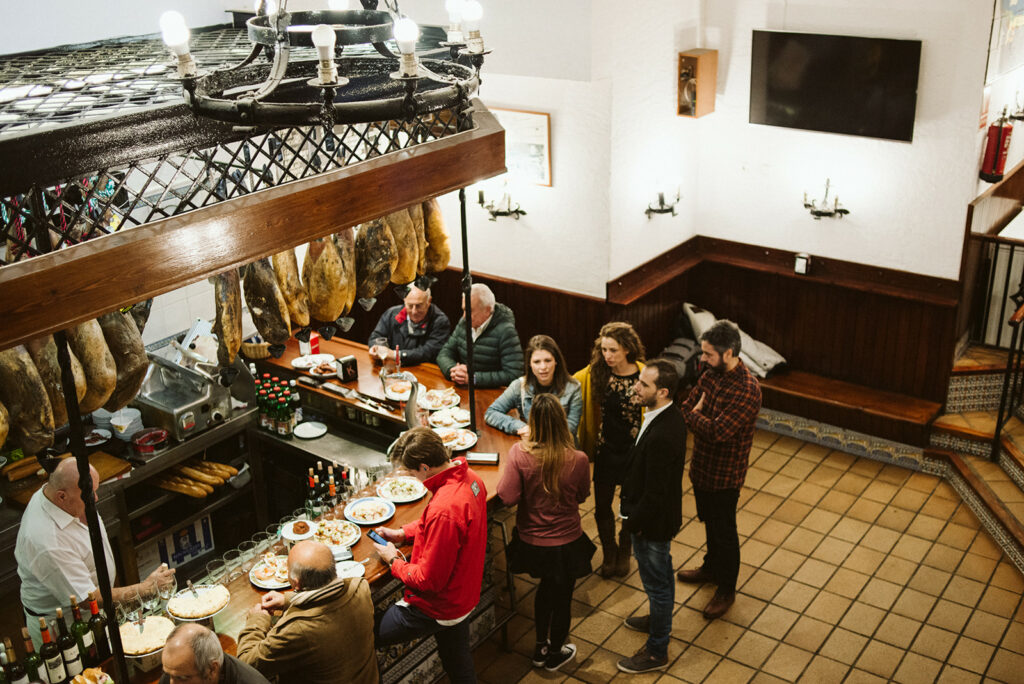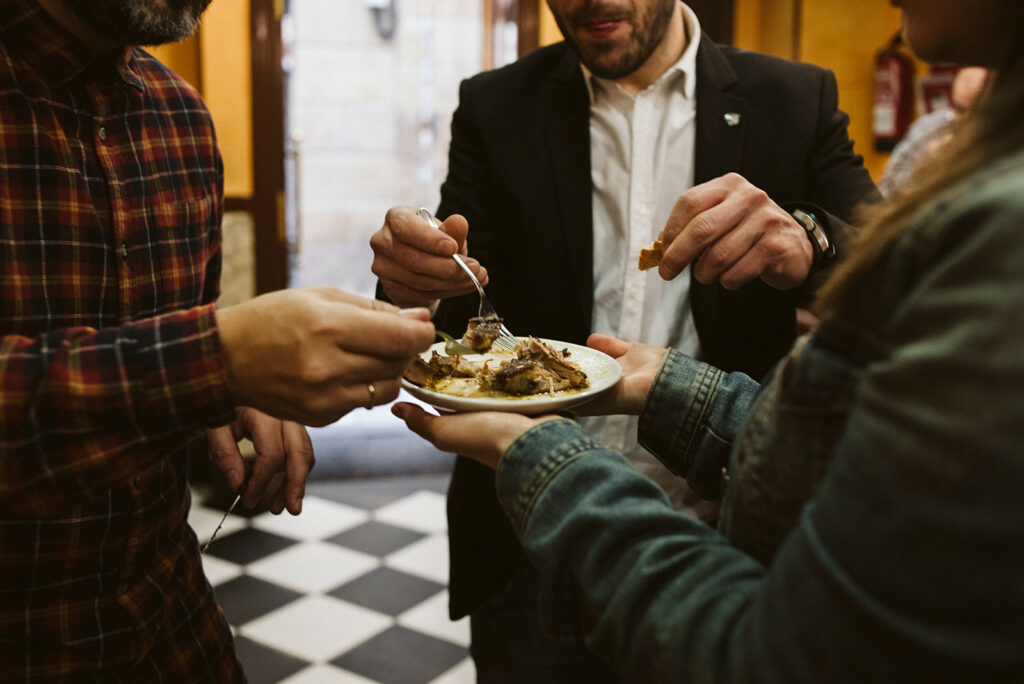We often think we travel to see things — beaches, museums, cathedrals, coastlines. But the most meaningful shifts usually come not from what we see, but from how we see.
San Sebastián will hand you a postcard-perfect view the moment you arrive: emerald hills, Belle Époque buildings, the curve of La Concha Bay so polished it almost feels staged. But this place doesn’t truly open through sightseeing. It opens through sensing.
What Happens When You Stop Just Visiting
The first few hours — or days — in a new city can feel like an audition. You’re alert, a little self-conscious, trying to “get it right.” You check off pintxo bars from a list. You walk past Miramar Palace because the guidebook said you should. You’re here — but still orbiting.
And then something shifts.
You stand behind a woman arguing with a fishmonger in San Martín Market over anchovies — not price, not weight, but freshness. She’s persuasive. She points. She smells them. She walks away empty-handed. That’s when you realize: food here is not just food. It’s reputation. It’s trust. It’s rhythm.
You walk into Bar Antonio and the handsome guy behind the counter already has the coffee cups out for the two elderly women who haven’t even sat down. They greet each other with two kisses and share a friendly Kaixo! and banter with the bartender. They order pintxo de tortilla without even looking. They’ve done this before.
This is not performance. This is culture in motion.
Culture is the Container
Culture isn’t just language or tradition. It’s the unwritten code that shapes how people interact. Who speaks first. Who waits. Who pays. Who insists. Where we stand. When we linger.

Places Become People
To feel like a temporary local, you don’t need to pass for one. You just need to participate. Here’s how:
- Start with coffee. San Sebastián takes it seriously — and so should you. Try Simona in Gros, where hipsters and visitors blend seamlessly, and the baristas serve with the casual warmth of people who live here year-round.
- Walk to Angiozar, where they roast and grind their own beans. They only serve coffee to go — a rarity here — but it’s worth it. No seating, no ceremony, just a machine making bold coffee in a space that only locals go to.
- Or go to Taba Café in Tabakalera, where film students, curators, creative thinked and freelancers make up the background hum. It’s part café, part cultural hub, and art museum and all of it feels in motion.
- Get your croissant — from Luque who bakes them fresh every morning ad fills them with pistachio or cream cheese.
- Walk to the port- get a view of the bay from the other side and walk from Paseo Salamanca to the port, the longest way you can walk without any traffic lights and the waves crashing to your right hand side.
- Start your pintxo crawl the right way and head to Bar Txepetxa Order a Gilda — olive, anchovy, guindilla pepper, speared with a toothpick — and sip a crisp glass of Txakoli. Smile at the bartender. Say Eskerrik asko (thank you). You won’t be fluent, but fluency isn’t the point. Effort is.
- Explore the old town and get more pintxos or choose a ¨menu del dia¨ at Pollitena where they always have fresh fish, bread, wine, water and seasonal starters. By now you’ll find out that if you want to sit to eat you must book a table even if it’s not formal.
- Then add something sweet — at Lurka Chocolate, ask for the seasonal bombón, or swap your usual espresso for a small, rich chocolate drink made with water instead of milk. It’s intense. It’s different. It’ll stay with you.
- Learn to look at food differently. Elkano sells cheeses with stories — local and unique, aged and fresh — and they’ll help you choose one based on your tastes. It’s not just a snack; it’s a sensory history lesson of the makers.
- And when the sun dips low and everyone starts drifting into bars, head to Akerbeltz, where locals and visitors meet at sidewalk tables without hierarchy or hurry and order a cool beer to enjoy with the sea behind you.
You don’t need to speak the language to feel the generosity. You just need to notice it.
Not Just a Place but a feeling
These rituals — the morning croissant, the afternoon Gilda, the smile exchanged in a crowded bar — start to create something larger than a travel itinerary. You feel a shift in your own rhythm. You’re not performing culture; you’re participating in it.
And it doesn’t take months. It takes presence.
In San Sebastián, culture happens in quiet, human-sized gestures. Someone offers you their table in a crowded bar without asking who you are. A stranger recommends a better wine. You greet someone with “Agur” instead of goodbye — and they smile like you’ve made the effort.
You may leave with a few souvenirs. But more than that, you leave with something you can’t pack: the memory of feeling included in someone else’s world, and maybe even leave the city a little bit better than how you found it.
San Sebastián doesn’t just welcome visitors — it invites participation. If you’re looking to connect in ways that feel natural, not forced, here are some experiences that open real doors into the life of the city.

Step Into a Shared Table
Pintxo Tours, Reimagined
This isn’t a food crawl — it’s a cultural deep-dive. On a guided pintxo tour with Eat One Feed One, you’re not just hopping from bar to bar tasting anchovies and sipping txakoli. You’re hearing stories. Watching bartenders in action. Sharing plates and opinions with strangers who stop feeling like strangers by the second stop. It’s not just about eating — it’s about belonging through food.
Explore Sweet San Sebastián
If savory isn’t your love language, opt for the dessert tour instead. This one moves through the city’s pastry shops, chocolate makers, wine bars and cheese counters. It’s indulgent, yes — but it also reveals a sweeter layer of the city’s history, full of family-owned shops and small stories.
Community, Without the Awkward Icebreakers
Karaoke and Quiz Night at Bidasoa Tap Room
Gros is the kind of neighborhood where locals hang out because they want to, not because they’re supposed to. At Bidasoa Tap Room, you’ll find more than great beer. On karaoke nights, the vibe is low-pressure and high-fun. People sing badly. People cheer anyway. No one takes themselves too seriously.
On quiz nights, teams are mixed — intentionally. You might show up alone, but before the first question is asked, you’ll already be part of a group. A little competition, a few laughs, and zero awkwardness.
English Chat Meet-Up at Tabakalera
Every Monday evening at Tabakalera, a group gathers in the café space to simply… talk. No agenda, no formalities. Just locals and travelers coming together for a relaxed English-language conversation. If you’re looking for low-stakes connection with curious people, this is it.
Move With the Locals
Surf Lessons on Zurriola Beach
You don’t need to be good at surfing to join a lesson — you just need to show up. With small group sessions, instructors make it feel like a shared adventure instead of a solo struggle. It’s part sport, part storytelling: the sea teaches you things quickly, and so does the person cheering you on next to you.
(Check out local surf schools like Kresala or Indarra — both are rooted in the community.)
Find Fellow Travelers
Backpackr
Solo doesn’t have to mean solitary. Backpackr helps you find other travelers nearby — people with similar plans, curiosities, and timelines. Whether you’re looking to hike, taste, or just sit by the sea and chat, this platform helps you turn “I wish I knew someone here” into “Let’s go together.”

